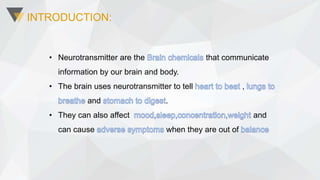Physiology Neurotransmitter (nervous system) ppt
- 2. INTRODUCTION OF THE NERVES SYSTEM: ŌĆó Nervous System Of The Body. ŌĆó There are a parts of nervous system. A. Central Nervous System B. Peripheral Nervous System
- 3. NERVOUS SYSTEM 1. Brain 2. spinal cord 1. Autonomic Nervous system A. Sympathetic B. parasympathetic 2. Somatic Nervous System
- 4. LOREM IPSUM DOLOR LOREM Lorem ipsum dolor sit amet, consectetur adipisicing elit, sed do eiusmod tempor incididunt ut labore et dolore magna aliqua. Ut enim ad minim veniam, quis nostrud exercitation ullamco laboris nisi ut aliquip ex ea commodo consequat.
- 5. LOREM IPSUM DOLOR Lorem ipsum dolor sit amet, consectetur adipisicing elit.
- 6. ŌĆó NEURON Also called a nerve cells ŌĆó Is as the and unit of Nervous System. There are a main parts of the nerve cells I. Cell Body ii. Dendrite iii. Axon 01 NEURO N
- 8. Cross Sections Of a Nerve
- 9. Synapse ŌĆó Synapse Is The Between Two Neurons. ŌĆó Is The ŌĆ£ ŌĆØ Between The Axon Of One Nerve And The Dendrite Of The Next One
- 13. INTRODUCTION: ŌĆó Neurotransmitter are the that communicate information by our brain and body. ŌĆó The brain uses neurotransmitter to tell , and . ŌĆó They can also affect and can cause when they are out of
- 14. NEUROTRANSMITTER ............... is a That acts as a for the transmission of nerve from one neuron to another neuron by a DEFINITION:
- 15. branching fiber that from other neuron ddsfsff Are the point where the axon Is a thin fiber where is from the neuron to other neurons This is a NEURON
- 16. TRANSPORT AND RELEASE OF NEUROTRANSMITTER:- a neurotransmitter. ŌĆó and to the . ŌĆó AT. the ,the neurotransmitter is in small it called a . ŌĆó then,vesicle and the nurotransmitter into . ŌĆó it to on the surface of the .
- 18. Transmision ŌĆó It travels by the Axon ŌĆó come from soma ŌĆó from the pre - synapti terminal ŌĆó to the next neuron ŌĆó it re-uptake sometime occure
- 19. 1. it must be found in neuron. 2. produce by a neuron 3. released by a neuron 4. after,it must be act on a target area and produce some biological effect 5. after the action it must be Inactivated CRITERI FOR NEUROTRANSMITTER: Many substances are categorise.to consider a neurotransmitter
- 20. CLASSIFICATION OF NEUROTRANSMITTER: ŌĆó DEPENDING UPON THE CHEMICAL NATURE 1. Amino Acids 2. Amines 3. others
- 21. . Amino acid ŌĆó This group are involved in and are inhibitory and excitatory in action. ŌĆó EXAMPLE : GABA (gamma aminobutyric acid), Glycine , glutamic acid , aspartate acid
- 22. . Amines ŌĆó Amines are the . ŌĆó that involv in .these neurotransmitter are also inhibitory and excitatory in action. ŌĆó EXAMPLE: Noradrenaline , adrenaline , dopamine , histamine
- 23. 3. others ŌĆó some neurotansmitter do not fit into any of these categories. ŌĆó one such substance is . ŌĆó othe substance include in this category is the soluble gass ( )
- 24. DEOENDING UPON THE FUNCTION: ’ü▒ There are two type .. 1. Excitatory nurotransmitters 2. Inhibitory neurotransmitter
- 25. EXCITATORY NEUROTRANSMITTER: ’ā╝ Action potential down of another . ’ā╝ Release of . of on cell membrane . of ligand gate . ’ā╝ flow of in the cell. ’ā╝ cell become . ’ā╝ Leads to a . ’ā╝ Known as a . Examples:- ’é¦ Acetylcholine ’é¦ Histamine ’é¦ Norepinephrinr
- 26. INHIBITORY NEUROTRANSMITTER:- ’ā╝ Actionof Inhibitory neurotransmitter. ’ā╝ action potential of another nerve cells. ’ā╝ releases of neurotransmitter. ’ā╝ Activation of on cells . ’ā╝ opening of . ’ā╝ flow of of cells. ’ā╝ Lead to . ’ā╝ Known as . ’ü▒ Example: ŌĆó GABA ŌĆó Dopamine
- 27. EXCITATORY AND INHIBITORY NEUROTRANSMITTER:- EXCITATORY NEUROTRANSMITTER: INHIBITORY NEUROTRASMITTER: NEUROTRANSMITTER WITHE BOTH ACTION: 1. Acetylcholine 1. GABA 1. Noradrenaline 2. nitric oxid 2. glycne 2.adrinaline 3. Histamine 3. dopamine 4.aspartate 4.serotonin
- 28. IMPORTANT NEUROTRANSMITTER:- ’ü▒ Acetylcoline ’ü▒ Noradrenaline ’ü▒ Dopamine ’ü▒ Serotonin ’ü▒ Histamine ’ü▒ GABA ’ü▒ Nitric oxide
- 29. 1.ACETYLCHOLINE:- ’ā╝ Is a . ’ā╝ it possesses . ’ā╝ source: - Preganglionic parasympatheic nerve - Post-ganglionic parasympatheic nerve - Preganglionic Sympathetic nerve - many region of brain - Postganglionic Sympathetic cholinergic nerves ’ā╝ there are a types of receptors... 1. 2.
- 30. 2. NORADRENALINE:- ’ā╝ Noradrenaline is the neurotransmitter in . ’ā╝ it released.... 1. Postganglionic Sympathetic nerves ending 2. cerebral cortex 3. Hypothelamus 4. basal ganglia 5. brainsten 6 .spinal cord
- 31. 3. DOPAMINE:- area..relese 1.Basal Ganglia 2.Hypothalamus 3.Limbic system 4.Retina ’ā╝ It action is a .
- 32. 4. SEROTONIN:- ’ā╝ Large amount of serotonin( %) is found in of . ’ā╝ small amount found in and . ’ā╝ its secreted... 1.hypothalamus 2.Limbic system 3.cerebellum 4.Midbrain 5.GI tract
- 33. 5. HISTAMINE:- ’ā╝ Is secreted in nerve e ending of , , and other part of the . ’ā╝ it also secrete by the and .
- 34. 6.GAMMA- AMNOBUTYRIC ACID(GABA):- ’ā╝ Its a inhibitory neurotransmitter in synapses particular in . ’ā╝ secreted ..... 1.cerebral cortex 2.cerebellum 3.basal ganglia 4.spinal cord
- 35. 7.NITRIC OXIDE:- ’ā╝ NO Is the in the . ’ā╝ its important in the Between
- 36. THANKS



































